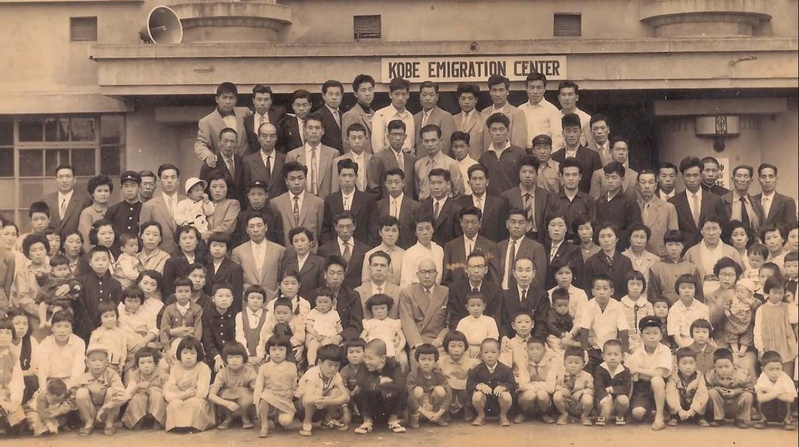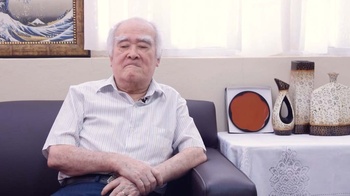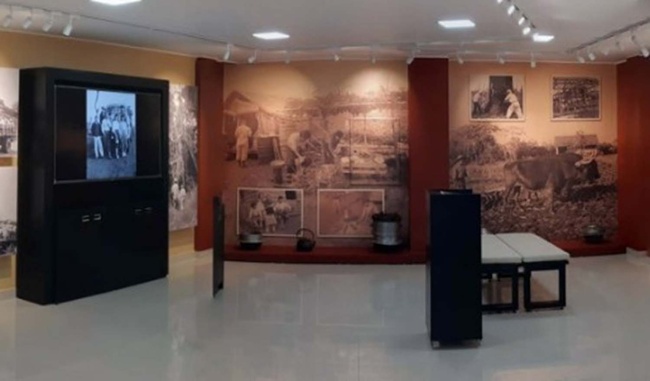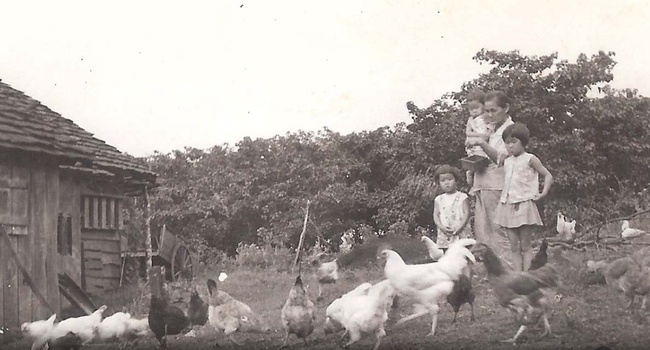“We wanted any place in America to come and live. We heard very nice things about Paraguay,” says Ryuichi Hashimoto.
“There was propaganda (in Japan) that land in Paraguay was cheap,” recalls Kaoru Nishii.
Both are Issei. They left their country in the 1950s and are part of a group of immigrants that the Japanese Association of Encarnación has interviewed to recover their stories and the story of their community.
The association seeks to preserve and transmit these stories, building a heritage for young generations. Looking at the past, they also at the present and the future.
THE BOILER, THE BEGINNING
It all started with—literally—a piece of history. One day, members of the association found a boiler in an area where the Japanese language school now operates.
The place where it was found temporarily housed immigrants recently arrived from Japan and the boiler was used to heat the water for the ofuro. (The premises that the association occupies today belonged to the institutions in charge of receiving the Issei in successive stages: the Public Corporation of the Japanese Emigration Service and the Japan International Cooperation Agency.)
Without searching for it, they had found a treasure, the last material vestige of a founding era, a door to a past full of hope and sacrifice, uncertainty and struggle for survival.
It was not a matter of polishing the object and storing it like old dishes. It was a relic, but also a living piece, a spur to action.
The cauldron set the association in motion.
First, they moved it to a more visible place to display it. Secondly, they noted the need to create a space for the dissemination and appreciation of the history of Japanese immigrants. That was the first outline of the Nikkei Paraguayan Identity Center, founded in 2020.
What better than for the protagonists themselves to tell their stories, the association thought. And overcoming the difficulties generated by the pandemic, they set out to collect testimonies such as those of Ryuichi Hashimoto and Kaoru Nishii, which they gathered in a documentary published on their website.
Japanese immigration to Paraguay began in 1936, before World War II. In the 1950s, a new wave of migration took shape. With photos and interviews, the Center narrates this second stage through the Issei who entered the country through the city of Encarnación.
CROSSING THE WORLD
Issei Sakae Oda remembers how hard life was in post-war Japan. “There was always a lack of food,” he says. With his family he embarked to Paraguay in 1957.
Kuniharu Gono, who traveled to America the same year, relates: “Our rice field was destroyed, and so were our spirits. We no longer wanted to work there, and that was when we heard about emigration to South America.”
In his case, the farewell was particularly painful. Originally from the Hokkaido prefecture, in the far north of Japan, no relative was able to accompany him to the port to say goodbye, unlike other migrants escorted by their families.
“I didn't have anyone. I really felt very sad at that moment,” he recalls.
For some, the trip was an adventure, especially for the children. “As I was a child back then it was very fun to travel by boat, but we were very afraid when there was a storm. Our room was very low, and we saw the movement of the sea water right outside our window,” says Hiroaki Sakanashi, who left Japan in 1954.
Others like Naoshi Yomogida, a passenger on the Argentina Maru in 1963, arrived in Paraguay through the Panama Canal. Although he was only a child, he realized that it was “a gigantic work.”
On trips there was also room to celebrate and maintain Japanese traditions. Masuko Takimoto remembers that an undokai was organized on the high seas. “At that time the boat wasn't moving much, and I remember it was a beautiful day,” he says.
For immigrants, leaving Japan meant hearing languages other than Japanese for the first time and meeting people from other ethnic groups.
Ichiko Tanii, a native of Wakayama prefecture and a passenger on the Chicharenga Maru in 1955, smiles: “The most beautiful thing about the trip was a port called Port Elizabeth, before Cape Town, in Africa. There really were beautiful flowers. My sister plucked a flower and the caretaker came to get our attention. He was a tall, black-skinned man whose teeth were very white when he smiled.”
Paraguay was not everyone's first destination. For example, Masuko Takimoto first settled in Bolivia with her family in the 1950s, then moved to Argentina, and finally, several years later in 1973, moved to Paraguay, where she put down roots.
The Japanese had a preview of the chaotic situation on the continent to which they were migrating (street riots, coups d'état, military dictatorships, and more) before they stepped off the ship.
Yoko Yomogida, who left Japan in 1955, remembers: “When we arrived in Buenos Aires, there had just been a civil revolution of the era of Juan Domingo Perón, and we couldn't get off at the port for a few days.”
Several groups reached their destination by crossing the Pacific Ocean, such as that of Mitsuru Kumagai, who on the Brazil Maru in 1957 crossed the Caribbean Sea through the Panama Canal and passed through Caracas, the Dominican Republic and the Amazon, among other points.
Others followed a different route that included Okinawa, Hong Kong, Singapore, Mauritius, Durban, Cape Town, Rio de Janeiro, Santos and Buenos Aires.
BUILDING A LIFE IN THE MIDDLE OF THE JUNGLE
Tanji Ishibashi, an immigrant who had put down roots in Paraguay in the 1940s, was a fundamental character in the settlement of the Issei in the city of Encarnación.
Tanji adopted the name Pedro, integrated into local society and became friends with one of the city's influential figures, the politically connected Mario González.
With his support, Don Pedro looked for newly arrived Issei in Buenos Aires and accompanied them to Encarnación, where he housed and fed them. There was onigiri and tsukemono for the newcomers, dishes that after a very long trip tasted heavenly.
Later, Don Pedro facilitated their transportation to the colonies, where they would work the land.
His daughter Celina, the first Nikkei born in Encarnación, says: “I believe that those who came first as immigrants will always remember my father. They arrived with their loads and had nowhere to go, there was no hotel, nothing. Dad had a warehouse where he kept things, rice, and they put them in there, I don't know how many families. There they were fed... They ate the rice as if it were the first time in history.”
Like many of their peers in Peru, immigrants in Paraguay soon discovered that the things they had been promised did not correspond to the realities.
They were painted a country with abundant and fertile lands, but in reality not all of the terrain was suitable for cultivation. They had to make their way through the jungle.
By the time they should return “millionaires” to their country, according to the siren song that sweetened their ears in Japan, the immigrants had not even been able to cut down all the trees to prepare the land for cultivation.
Although the work was hard, they had a great ally: youth. They were full of energy. Mieko Kumagai remembers: “We worked every day, but since we were young we slept one night and were already rested. We didn't know about the existence of Sundays. Only when it rained did we have free time.”
The only fun for them, she says, was sewing.
Leaving behind impoverished postwar Japan did not automatically eliminate hunger. “There was nothing to eat, not even vegetables, but since I was a child I ate what they gave me. It must have been a great sacrifice for our parents to obtain food under those circumstances,” recalls Aiko Kurosu.
They went through many hardships. There was no electricity or drinking water. They fell victims to insects. For some it was too much and they fell into depression, alcoholism and even committed suicide.
However, little by little, thanks to their efforts, the immigrants managed to make the colonies habitable and productive. They set up camps and built their houses.
They did everything together, helping each other in building their new lives. There was a lot of solidarity.
The women did not have the ingredients they used to cook in their native country, but they managed to prepare their dishes with what they could get.
Once settled in the countryside, the Issei dedicated themselves to the extensive cultivation of soybeans, wheat or corn. There were families who left the colonies to move to the city, where they would dedicate themselves mainly to commerce. Some immigrants set up businesses that are successful today.
One of them is the Hiroshima restaurant, named after the prefecture where the family that opened it was originally from. Its case exemplifies the tenacious work that decades later bears great fruit. The Odas went into debt to acquire a place.
Toshiharu Oda remembers: “We have paid debts for 25 to 30 years, we worked very hard to pay the interest, and we were still in debt even when we moved to the current Hiroshima restaurant.”
That is now in the past. Now it is the time of prosperity. “I think we have everything today because we made that sacrifice. Finally, now I can feel completely calm and free from all the sacrifices,” he says.
HARVEST TIME
Once basic needs were met, the Japanese threw themselves into the arms of entertainment. Not everything could be work—you also had to play sports (baseball, volleyball, table tennis, sumo, etc.), dance, do theater...
They created sports teams, theater groups, and music bands; they organized cultural festivals and sports championships.
In 1961, after several years of meetings, the Japanese Association of Encarnación was made official. The organization was born to maintain the language and traditions of Japan, promote the development of community members and strengthen mutual solidarity.
Two years later, to fulfill the association's main objective, the Japanese Language Institute was created. Its first classroom was in the courtyard of a private house.
Since then, the practice of various Japanese cultural manifestations has been actively promoted, a continuous work that, with new generations in action, has in the 21st century birthed groups that play taiko and dance yosakoi.
Today the Nikkei enjoy a positive image in Paraguay thanks to “their example of work, discipline and tenacity.”
Key to this has been the integrity that the immigrants brought from their country and instilled in their children. Naoshi Yomogida explains it: “That they know how to act like people and not cause shame; that is, to be people who are not pointed with the finger. It is the unanimous thought that my father transmitted to me and we transmitted to our children and grandchildren.”
Meanwhile, Paraguayans highlight their rapid integration into local society. “The Japanese mixed with us as if they were Paraguayans. In a year, a year and a half, they spoke Guaraní,” says Celso Silvero.
For his part, Víctor González appreciates the contribution of the Japanese to the country: “First, they came to contribute their culture. Very important. Second, they taught our Paraguayan countrymen how to work. Our Paraguayan countrymen learned how to work. They have contributed greatly to our economy here in the region. Their conduct is impeccable.”
All photos courtesy of the Nikkei Paraguayan Identity Center.
© 2024 Enrique Higa










